Concurrent sound segregation in electric and acoustic hearing
- PMID: 17216383
- PMCID: PMC2538412
- DOI: 10.1007/s10162-006-0068-1
Concurrent sound segregation in electric and acoustic hearing
Abstract
We investigated potential cues to sound segregation by cochlear implant (CI) and normal-hearing (NH) listeners. In each presentation interval of experiment 1a, CI listeners heard a mixture of four pulse trains applied concurrently to separate electrodes, preceded by a "probe" applied to a single electrode. In one of these two intervals, which the subject had to identify, the probe electrode was the same as a "target" electrode in the mixture. The pulse train on the target electrode had a higher level than the others in the mixture. Additionally, it could be presented either with a 200-ms onset delay, at a lower rate, or with an asynchrony produced by delaying each pulse by about 5 ms re those on the nontarget electrodes. Neither the rate difference nor the asynchrony aided performance over and above the level difference alone, but the onset delay produced a modest improvement. Experiment 1b showed that two subjects could perform the task using the onset delay alone, with no level difference. Experiment 2 used a method similar to that of experiment 1, but investigated the onset cue using NH listeners. In one condition, the mixture consisted of harmonics 5 to 40 of a 100-Hz fundamental, with the onset of either harmonics 13 to 17 or 26 to 30 delayed re the rest. Performance was modest in this condition, but could be improved markedly by using stimuli containing a spectral gap between the target and nontarget harmonics. The results suggest that (a) CI users are unlikely to use temporal pitch differences between adjacent channels to separate concurrent sounds, and that (b) they can use onset differences between channels, but the usefulness of this cue will be compromised by the spread of excitation along the nerve-fiber array. This deleterious effect of spread-of-excitation can also impair the use of onset cues by NH listeners.
Figures
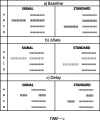
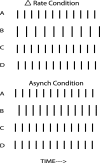

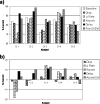

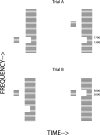
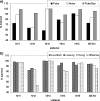

Similar articles
-
The effect of reducing the number of electrodes on spatial hearing tasks for bilateral cochlear implant recipients.J Am Acad Audiol. 2010 Feb;21(2):110-20. doi: 10.3766/jaaa.21.2.5. J Am Acad Audiol. 2010. PMID: 20166312 Free PMC article.
-
Masking release with changing fundamental frequency: Electric acoustic stimulation resembles normal hearing subjects.Hear Res. 2017 Jul;350:226-234. doi: 10.1016/j.heares.2017.05.004. Epub 2017 May 11. Hear Res. 2017. PMID: 28527538
-
Psychophysical recovery from pulse-train forward masking in electric hearing.J Acoust Soc Am. 2002 Dec;112(6):2932-47. doi: 10.1121/1.1514935. J Acoust Soc Am. 2002. PMID: 12509014
-
Sensitivity to interaural level and envelope time differences of two bilateral cochlear implant listeners using clinical sound processors.Ear Hear. 2004 Oct;25(5):488-500. doi: 10.1097/01.aud.0000145124.85517.e8. Ear Hear. 2004. PMID: 15599195
-
Music perception with cochlear implants: a review.Trends Amplif. 2004;8(2):49-82. doi: 10.1177/108471380400800203. Trends Amplif. 2004. PMID: 15497033 Free PMC article. Review.
Cited by
-
Comodulation masking release in speech identification with real and simulated cochlear-implant hearing.J Acoust Soc Am. 2012 Feb;131(2):1315-24. doi: 10.1121/1.3676701. J Acoust Soc Am. 2012. PMID: 22352505 Free PMC article.
-
Selective attention in normal and impaired hearing.Trends Amplif. 2008 Dec;12(4):283-99. doi: 10.1177/1084713808325306. Epub 2008 Oct 30. Trends Amplif. 2008. PMID: 18974202 Free PMC article. Review.
-
A partial hearing animal model for chronic electro-acoustic stimulation.J Neural Eng. 2014 Aug;11(4):046008. doi: 10.1088/1741-2560/11/4/046008. Epub 2014 Jun 12. J Neural Eng. 2014. PMID: 24921595 Free PMC article.
-
Auditory enhancement and the role of spectral resolution in normal-hearing listeners and cochlear-implant users.J Acoust Soc Am. 2018 Aug;144(2):552. doi: 10.1121/1.5048414. J Acoust Soc Am. 2018. PMID: 30180692 Free PMC article.
-
Evidence of the enhancement effect in electrical stimulation via electrode matching (L).J Acoust Soc Am. 2012 Feb;131(2):1007-10. doi: 10.1121/1.3672650. J Acoust Soc Am. 2012. PMID: 22352475 Free PMC article. Clinical Trial.
References
-
- {'text': '', 'ref_index': 1, 'ids': [{'type': 'DOI', 'value': '10.1016/j.heares.2004.06.008', 'is_inner': False, 'url': 'https://doi.org/10.1016/j.heares.2004.06.008'}, {'type': 'PubMed', 'value': '15464301', 'is_inner': True, 'url': 'https://pubmed.ncbi.nlm.nih.gov/15464301/'}]}
- Baumann U, Nobbe A. Pulse rate discrimination with deeply inserted electrode arrays. Hear. Res. 196:49–57, 2004. - PubMed
-
- None
- Bench J, Bamford J. Speech–Hearing Tests and the Spoken Language of Hearing-Impaired Children. London, Academic, 1979.
-
- {'text': '', 'ref_index': 1, 'ids': [{'type': 'DOI', 'value': '10.1007/s10162-003-3057-7', 'is_inner': False, 'url': 'https://doi.org/10.1007/s10162-003-3057-7'}, {'type': 'PMC', 'value': 'PMC2538368', 'is_inner': False, 'url': 'https://pmc.ncbi.nlm.nih.gov/articles/PMC2538368/'}, {'type': 'PubMed', 'value': '14564662', 'is_inner': True, 'url': 'https://pubmed.ncbi.nlm.nih.gov/14564662/'}]}
- Bierer JA, Middlebrooks JC. Cortical responses to cochlear implant stimulation: channel interactions. J. Assoc. Res. Otolaryngol. 5:32–48, 2004. - PMC - PubMed
-
- None
- Bregman AS. Auditory Scene Analysis. Cambridge, MA, M.I.T. Press, 1990.
-
- {'text': '', 'ref_index': 1, 'ids': [{'type': 'PubMed', 'value': '728845', 'is_inner': True, 'url': 'https://pubmed.ncbi.nlm.nih.gov/728845/'}]}
- Bregman AS, Pinker S. Auditory streaming and the building of timbre. Can. J. Psychol. 32:19–31, 1978. - PubMed
Publication types
MeSH terms
Grants and funding
LinkOut - more resources
Full Text Sources
Medical
Miscellaneous

